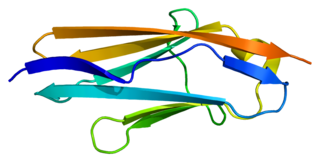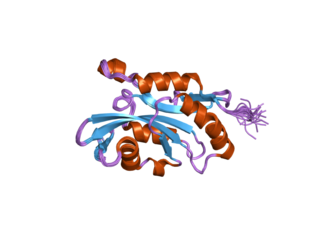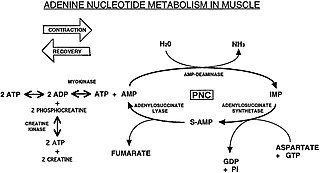
Adenosine monophosphate deaminase deficiency type 1 or AMPD1, is a human metabolic disorder in which the body consistently lacks the enzyme AMP deaminase, in sufficient quantities. This may result in exercise intolerance, muscle pain and muscle cramping. The disease was formerly known as myoadenylate deaminase deficiency.

Adenosine deaminase is an enzyme involved in purine metabolism. It is needed for the breakdown of adenosine from food and for the turnover of nucleic acids in tissues.

Prostatic acid phosphatase (PAP), also prostatic specific acid phosphatase (PSAP), is an enzyme produced by the prostate. It may be found in increased amounts in men who have prostate cancer or other diseases.

Deoxyadenosine triphosphate (dATP) is a nucleotide used in cells for DNA synthesis, as a substrate of DNA polymerase. It is classified as a purine nucleoside triphosphate, with its chemical structure consisting of a deoxyribose sugar molecule bound to an adenine and to three phosphate groups. It differs from the energy-transferring molecule adenosine triphosphate (ATP) by a single hydroxyl group, resulting in a deoxyribose instead of a ribose. Two phosphate groups can be hydrolyzed to yield deoxyadenosine monophosphate, which can then be used to synthesize DNA.

Adenylosuccinate lyase is an enzyme that in humans is encoded by the ADSL gene.

Tropomyosin alpha-3 chain is a protein that in humans is encoded by the TPM3 gene.

Collagen alpha-2(VI) chain is a protein that in humans is encoded by the COL6A2 gene.

A-kinase anchor protein 5 is a protein that in humans is encoded by the AKAP5 gene.

Myosin-2 is a protein that in humans is encoded by the MYH2 gene.

Voltage-dependent L-type calcium channel subunit beta-1 is a protein that in humans is encoded by the CACNB1 gene.

Concentrative nucleoside transporter 2 (CNT2) is a protein that in humans is encoded by the SLC28A2 gene.

AMP deaminase 3 is an enzyme that in humans is encoded by the AMPD3 gene.

cAMP-dependent protein kinase inhibitor alpha is a protein that in humans is encoded by the PKIA gene.

Acetylcholinesterase collagenic tail peptide also known as AChE Q subunit, acetylcholinesterase-associated collagen, or ColQ is the collagen-tail subunit of acetylcholinesterase found in the neuromuscular junction. In humans it is encoded by the COLQ gene.

Adenylate kinase 2 is an enzyme that is encoded in humans by the AK2 gene. The AK2 protein is found in the intermembrane space of the mitochondrion.

Striated muscle preferentially expressed protein kinase, in the human is encoded by the SPEG gene, a member of the myosin light chain kinase protein family. SPEG is involved in the development of the muscle cell cytoskeleton, and the expression of this gene has important roles in the development of skeletal muscles, and their maintenance and function. Mutations are associated with centronuclear myopathies a group of congenital disorders where the cell nuclei are abnormally centrally placed.

AMP deaminase 2 is an enzyme that in humans is encoded by the AMPD2 gene.

Cat eye syndrome critical region protein 1 is a protein that in humans is encoded by the CECR1 gene.

Cofilin 2 (muscle) also known as CFL2 is a protein which in humans is encoded by the CFL2 gene.

The Purine Nucleotide Cycle is a metabolic pathway in protein metabolism requiring the amino acids aspartate and glutamate. The cycle is used to regulate the levels of adenine nucleotides, in which ammonia and fumarate are generated. AMP coverts into IMP and the byproduct ammonia. IMP converts to S-AMP (adenylosuccinate), which then coverts to AMP and the byproduct fumarate. The fumarate goes on to produce ATP (energy) via oxidative phosphorylation as it enters the Krebs Cycle and then the Electron Transport Chain. Lowenstein first described this pathway and outlined its importance in processes including amino acid catabolism and regulation of flux through glycolysis and the Krebs cycle.

























